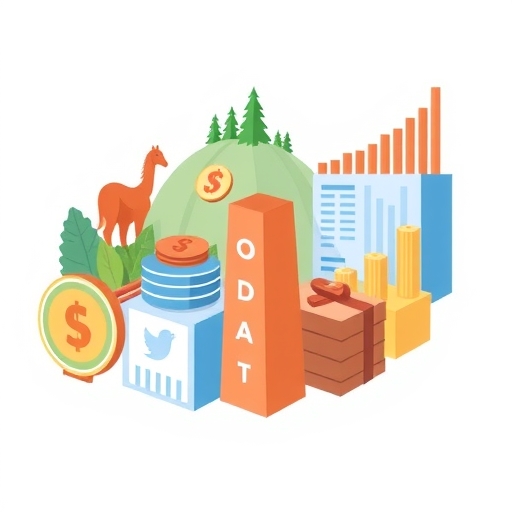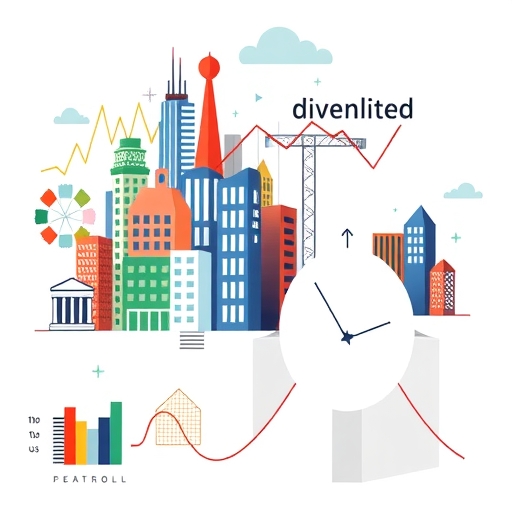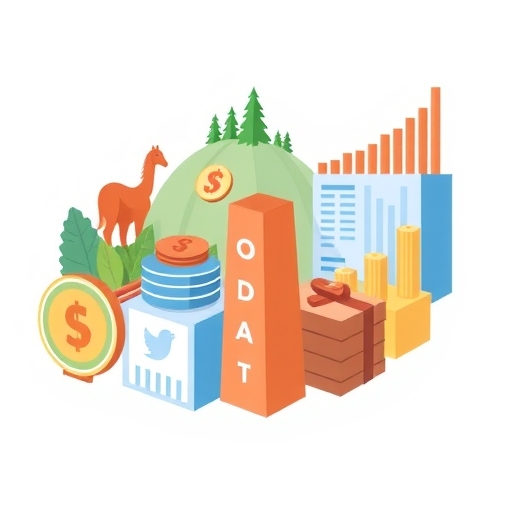Unlocking Diversification: A Deep Dive into Commodity ETFs and Indices for Modern Portfolios
In today’s dynamic financial landscape, traditional investments in equities and bonds face increasing uncertainty, prompting investors to explore alternative avenues for protecting and enhancing their portfolios. Have you ever wondered how to protect your investments from inflation or add a layer of diversification beyond stocks and bonds? Commodities have long stood out as a powerful asset class, historically offering unique diversification benefits and a vital hedge against inflation. This article will explore the mechanisms of commodity investing through specialized indices and the increasingly popular Exchange Traded Funds (ETFs), providing a comprehensive guide to understanding their types, benefits, risks, and strategic integration into a well-balanced investment strategy. We’ll break down complex concepts, examine various types of commodity ETFs, and discuss how you can smartly incorporate them into your financial plan.
The Foundational Role of Commodity Indices in Investment Strategy
Before diving into commodity ETFs, it’s crucial to understand the benchmarks they often track: commodity indices. These indices are like baskets of different commodities, each weighted according to specific rules, aiming to represent the overall performance of the commodity market or a particular sector within it. They provide a standardized way to measure commodity market performance and are essential for investors looking to gain broad exposure.
Several prominent commodity indices exist, each with unique methodologies that influence their performance and characteristics. Let’s explore some of the most influential ones:
- Dow Jones Commodity Index (DJCI): Launched in 2014, but with 26 years of historical data, the DJCI is a broad-based index holding 29 commodity futures contracts across various sectors, including agriculture, livestock, energy, and metals. What makes the DJCI unique? It emphasizes liquidity weighting, meaning commodities that are more actively traded get a higher weight. It also reweights monthly, equally weights between commodity sectors, and caps individual commodity component weight at 32% (or 17% for specific others). Historically, it has offered increased diversification and superior performance compared to some older indices.
- S&P GSCI: This is a long-standing measure of commodity beta, providing a traditional benchmark for commodity performance. It is known for its energy-heavy weighting and has been a blueprint for next-generation thematic indices designed for diversification and inflation protection.
- Bloomberg Commodity Index (BCOM): Tracking 23 commodities, BCOM selects its components based on economic significance (production), diversification, continuity, and liquidity. It caps single commodities at 15% and segments (like energy or agriculture) at 33%, aiming for a more diversified exposure than some other indices.
- Rogers International Commodity (RICI) Index: This index tracks 38 commodities, with its composition dependent on global consumption and liquidity. A committee reviews its components, and it is rebalanced monthly.
- Optimised Roll Commodity Index: Based on the BCOM composition, this index aims to outperform by optimizing “roll returns.” It achieves this through monthly adjustment of futures contract maturities, attempting to minimize the negative impact of rolling expiring futures contracts.
- UBS CMCI Index: Tracking 28 commodities across five sectors, the UBS CMCI Index diversifies futures across the maturity curve for constant maturities. This strategy aims to minimize negative roll yield, a common issue with futures-based commodity investments. It caps the largest commodity at 35% and others at 20%.
A common thread among most broad-based commodity indices is that they typically hold front-month futures contracts, meaning the contracts closest to their expiration date. They also generally roll these contracts monthly and rebalance their composition annually, often in January. Understanding these methodologies helps us appreciate how commodity ETFs translate commodity market movements into investment opportunities.
To further understand the breadth of commodities, it is useful to categorize them into major groups:
| Category | Examples | Key Uses |
|---|---|---|
| Energy | Crude Oil, Natural Gas, Gasoline | Fuel, electricity generation, industrial processes |
| Precious Metals | Gold, Silver, Platinum, Palladium | Jewelry, industrial, investment (safe haven) |
| Industrial Metals | Copper, Aluminum, Zinc, Nickel | Construction, manufacturing, electronics |
| Agriculture | Corn, Wheat, Soybeans, Coffee, Sugar | Food, animal feed, biofuels |
| Livestock | Live Cattle, Lean Hogs | Food production |
Demystifying Commodity ETFs: Types, Mechanisms, and Operational Insights
So, what exactly is a Commodity ETF? Simply put, it’s an exchange-traded fund that tracks the price movement of an underlying commodity or a commodity index, trading like a stock on a regular exchange. This makes it incredibly convenient for you to gain exposure to commodities without directly buying futures contracts or storing physical assets like gold bars in your home.
The mechanism behind commodity ETFs typically involves the fund tracking performance using either futures contracts, forwards, swaps, or by holding physical assets. This means that when you invest in a commodity ETF, you own units of the fund, not the physical commodities themselves (with some notable exceptions).
Let’s break down the different types of commodity ETFs you might encounter:
- Physically Backed ETFs: These funds actually hold the physical commodity in storage, usually in secure vaults. A prime example is a gold ETF that holds physical gold bars. While they incur storage and insurance costs, they largely avoid the complexities and “roll costs” associated with futures contracts. This type offers direct exposure to the spot price of the commodity.
- Futures-Based ETFs: The most common type, these ETFs gain exposure by buying and selling futures, forwards, or swap contracts on the underlying commodities. For example, an oil ETF might hold futures contracts for crude oil. While efficient, these ETFs are subject to what’s known as “roll costs” (or contango/backwardation effects) and potential tracking errors. Roll costs occur because futures contracts have expiration dates, and the fund must “roll” its position from an expiring contract to a new one further out in time. If the new contract is more expensive than the expiring one (a situation called “contango”), the fund loses money on the roll, which can eat into returns over time.
- Equity-Based ETFs: Rather than holding commodities or futures, these ETFs invest in the stocks of companies involved in commodity production, exploration, or processing. For instance, a gold mining ETF invests in shares of companies that mine gold. While offering exposure to the commodity sector, their performance is also influenced by company-specific factors and stock market dynamics, not just commodity prices.
- Commodity Exchange Traded Notes (ETNs): These are debt contracts issued by financial institutions, linked to the return of a commodity index. While generally categorized with ETFs for convenience, it’s important to remember they carry credit risk of the issuing institution, unlike traditional ETFs. They are promises to pay a return linked to the index, not ownership of assets.
When considering futures-based ETFs, understanding terms like “roll costs” and “tracking error” is paramount. Tracking error refers to the difference between the ETF’s performance and the performance of its underlying index. It can occur due to fees, expenses, and the complexities of managing futures contracts, especially when markets are in contango or backwardation. This is why careful selection, based on factors like tracking accuracy, is so important.
Strategic Advantages and Inherent Risks of Commodity ETF Investment
Investing in commodity ETFs can offer compelling benefits for your portfolio, but like any investment, they come with their own set of risks. Let’s explore both sides so you can make an informed decision.
Benefits of Commodity ETFs:
- Diversification: This is arguably the biggest advantage. Commodity prices often have a low correlation with traditional assets like stocks and bonds. What does this mean for you? When stock markets are struggling, commodity prices might be holding steady or even rising, acting as a counterbalance in your portfolio. This can help reduce overall portfolio volatility and strengthen diversification, particularly during market downturns.
- Inflation Hedge: Commodity prices tend to rise when inflation is picking up. Think about it: if the cost of raw materials (like oil, food, or metals) goes up, the prices of finished goods and services often follow. By investing in commodities, you’re essentially owning assets that are likely to increase in value as inflation erodes the purchasing power of currency. This makes them a powerful tool for inflation protection.
- Convenience: Commodity ETFs provide easy access to commodity price movements without the hassle of physical storage (imagine buying and storing barrels of oil!) or the complexities of directly trading futures contracts, which often require specialized knowledge and accounts. They trade on exchanges just like regular stocks, making them highly liquid and accessible.

Risks of Commodity ETFs:
-
Price Volatility: Commodities are notoriously susceptible to sudden and significant price swings. Unpredictable events like severe weather, geopolitical conflicts (e.g., wars, trade disputes), supply chain disruptions, or changes in global demand can cause rapid shifts in prices. This means your investment can experience considerable ups and downs.
Understanding the factors that influence commodity prices is crucial for investors. These can include:
- Global economic growth and industrial demand for raw materials.
- Supply disruptions caused by geopolitical events, natural disasters, or labor strikes.
- Changes in weather patterns impacting agricultural output.
- Currency fluctuations, as many commodities are priced in USD.
- Speculative trading activity and investor sentiment.
- Tracking Error: As we discussed, derivatives-based (futures-based) ETFs may not perfectly track their benchmarks over time. Factors like management fees, expenses, and the complexities of “rolling” futures contracts can lead to a divergence between the ETF’s performance and the underlying commodity index it aims to follow. This is a crucial consideration for long-term investors.
-
Tax Differences: Depending on your jurisdiction and the specific type of commodity ETF, tax treatment can vary. For instance, in some countries like India, physically held precious metals ETFs (like gold and silver) may incur higher capital gains tax rates, potentially being treated as “collectibles” rather than traditional equity or debt funds. It’s always wise to consult a tax advisor to understand the implications for your specific situation.
To help navigate the terminology, here’s a quick glossary of some key terms related to commodity investing:
Term Definition Contango A market condition where the futures price is higher than the expected future spot price, or a longer-dated futures contract is more expensive than a shorter-dated one. Leads to negative roll yield for futures-based ETFs. Backwardation A market condition where the futures price is lower than the expected future spot price, or a longer-dated futures contract is cheaper than a shorter-dated one. Can lead to positive roll yield. Roll Yield The gain or loss generated when an expiring futures contract is replaced with a new, longer-dated contract. Influenced by contango/backwardation. Spot Price The current market price at which a commodity can be bought or sold for immediate delivery.
While commodity ETFs offer unique benefits, it’s vital to weigh these against their inherent risks. A balanced understanding is key to integrating them wisely into your investment strategy.
Navigating the Commodity ETF Market: Selection Criteria and Performance Analysis
With so many commodity ETFs available, how do you choose the right one for your portfolio? Selecting a high-quality commodity ETF involves looking beyond just recent performance. We need to consider several key analytical factors to ensure the fund aligns with your investment goals and risk tolerance.
Key Analyst Selection Criteria for Commodity ETFs:
- Low Expense Ratio (TER): This is the annual fee you pay to the fund manager, expressed as a percentage of your investment. A lower expense ratio means more of your returns stay in your pocket. Even small differences can add up significantly over time.
- High Tracking Accuracy (Low Tracking Error): As discussed, tracking error measures how closely an ETF’s performance mirrors its underlying index. You want an ETF with a consistently low tracking error, indicating efficient management and accurate replication of the benchmark.
- Good Liquidity/Trading Volume: Liquidity refers to how easily you can buy and sell ETF units without significantly impacting its price. ETFs with high trading volumes are generally more liquid, meaning you can enter or exit your position efficiently.
- Stable Historical Performance: While past performance is not indicative of future results, a history of stable and consistent returns, especially in varying market conditions, can be a positive indicator of the fund’s management quality.
- Understanding of Demand-Supply Balance: For specific commodity ETFs, it’s helpful to consider the fundamental supply and demand dynamics of the underlying commodity. For instance, factors affecting crude oil supply (e.g., OPEC decisions, geopolitical events) or gold demand (e.g., central bank purchases, safe-haven demand) can significantly impact prices.
- Credibility of the Fund House (AMC): The reputation and experience of the Asset Management Company (AMC) managing the ETF are crucial. A reputable fund house often implies robust risk management, transparent operations, and reliable customer service.
Market Overview and Performance Insights:
Commodity ETFs are indeed gaining popularity as a smart investment option for many. Let’s look at some examples and consider how their performance can vary. We’ll use hypothetical data for illustration, but remember that actual performance fluctuates daily.
Different commodity ETFs and indices can show varying returns over different periods, highlighting the importance of understanding their underlying composition and methodology. For example, while the Dow Jones Commodity Index (DJCI) has demonstrated superior performance and reduced volatility compared to the S&P GSCI and Bloomberg Commodity Index (BCOM) over certain periods, this isn’t guaranteed to continue. Indices like the Optimised Roll Commodity Index and UBS CMCI Index actively manage futures contract maturities to mitigate negative roll yields, which can lead to enhanced performance compared to simpler front-month strategies.
When comparing ETFs, you might see data like this (hypothetical example):
| ETF Name (Example) | Underlying Commodity/Index | Fund Size (AUM) | Expense Ratio (TER) | 1-Year Return (Hypothetical) | 3-Year Annualized Return (Hypothetical) |
|---|---|---|---|---|---|
| Invesco DB Commodity Index Tracking Fund (DBC) | DBIQ Optimum Yield Diversified Commodity Index | $3.5 Billion | 0.85% | +12.5% | +8.2% |
| SPDR Gold Trust (GLD) | Gold Spot Price | $60 Billion | 0.40% | +18.0% | +5.5% |
| iShares Diversified Commodity Swap UCITS ETF | Bloomberg Commodity Index Total Return | $1.2 Billion | 0.48% | +10.1% | +7.0% |
| Nippon India ETF Gold BeES | Gold Spot Price (India) | INR 8,000 Crore | 0.50% | +17.5% | +6.0% |
As you can see, fund size (Assets Under Management or AUM), expense ratio, and performance metrics vary significantly. Large AUM often indicates higher liquidity, while a lower TER directly impacts your net returns. Comparing these factors helps you make an informed choice.
Integrating Commodity ETFs into Your Diversified Portfolio
Now that we’ve explored what commodity ETFs are and how to evaluate them, let’s discuss how you can strategically integrate them into your investment portfolio to maximize their benefits.
The Role in a Diversified Portfolio:
Commodity ETFs strengthen diversification by offering a low correlation to traditional asset classes like equity, debt, and real estate. This means they often move independently or even inversely to these assets, helping to balance overall portfolio risk. When your stocks are down, your commodity holdings might be up, smoothing out your overall returns. 
For many investors, a modest allocation to commodity ETFs can significantly enhance portfolio resilience, especially against inflationary pressures. Rebecca Kaufman, Senior Associate, Commodities, Real & Digital Assets at S&P Dow Jones Indices, highlights the historical role of commodities in providing crucial portfolio diversification and inflation protection, proving valuable amidst economic uncertainty.
Recommended Allocation and Smart Entry Strategies:
So, what’s a typical allocation? While it always depends on your individual financial goals and risk profile, analysts often suggest allocating a small percentage of your portfolio to commodities. A common recommendation is typically 5%-10% of a portfolio for diversification purposes. This allows you to reap the benefits without exposing your portfolio to excessive commodity price volatility.
For smart entry into commodity ETFs, especially given their volatility, consider using Systematic Investment Plans (SIPs). An SIP involves investing a fixed amount regularly (e.g., monthly) regardless of market conditions. This strategy, known as Rupee Cost Averaging, helps you average out your purchase price over time, mitigating the impact of market fluctuations and reducing the risk of investing a lump sum at a market peak. It’s like a clear teacher guiding you step-by-step through the market’s ups and downs.
While commodities offer excellent diversification, a truly robust portfolio often includes:
- Equities from various sectors and geographies.
- Fixed-income instruments like government and corporate bonds.
- Real estate, either directly or through REITs.
- Alternative investments such as private equity or hedge funds (for suitable investors).
Taxation Considerations (Example from India):
It’s crucial to understand the tax implications of commodity ETFs in your region. For instance, in India, commodity ETFs (especially those tracking gold and silver) are treated differently from equity mutual funds for taxation purposes. Here’s a simplified overview:
- Short-Term Capital Gains (STCG): If you hold the ETF units for less than 12 months, any gains are considered short-term and are taxed at your income slab rates.
- Long-Term Capital Gains (LTCG): If you hold the ETF units for 12 months or more, any gains are considered long-term and are taxed at 20% with the benefit of indexation. Indexation adjusts your purchase price for inflation, effectively reducing your taxable gain and potentially lowering your tax liability. This makes long-term holding more appealing for certain commodity ETFs.
Always consult with a qualified financial advisor or tax professional to understand the specific tax rules applicable to your situation before making investment decisions.
Focusing on a long-term perspective for commodity investments can yield several advantages:
- Potential for significant capital appreciation during inflationary cycles.
- Reduced impact of short-term price volatility through averaging.
- Alignment with global economic trends and growing demand for raw materials.
Conclusion
Commodity ETFs have emerged as an accessible and intelligent investment choice for those seeking to enhance portfolio diversification and gain protection against inflationary pressures, operating independently from traditional equity and debt markets. By understanding the underlying commodity indices, the various types of ETFs (physically-backed, futures-based, equity-based), their inherent risks (like roll costs and tracking error) and compelling benefits (diversification and inflation hedge), and employing diligent selection criteria, you can effectively leverage these unique financial instruments. 
Strategic integration, thoughtful asset allocation (perhaps 5%-10% of your portfolio), and continuous portfolio review will pave the way for a more resilient and potentially profitable investment journey in the evolving global financial landscape. Remember, the goal is not just to chase returns, but to build a robust portfolio that can withstand various economic cycles.
Disclaimer: This article is for informational and educational purposes only and does not constitute financial advice. Investing in commodity ETFs involves risks, including the potential loss of principal. Always conduct your own research and consult with a qualified financial advisor before making any investment decisions.
Frequently Asked Questions (FAQ)
Q: What is a commodity ETF?
A: A commodity ETF (Exchange Traded Fund) is an investment fund that tracks the price movement of an underlying commodity or a commodity index. It trades like a stock on a regular exchange, allowing investors to gain exposure to commodities without directly buying physical assets or futures contracts.
Q: Why are commodity ETFs considered beneficial for portfolio diversification?
A: Commodity ETFs are beneficial for diversification because commodity prices often have a low correlation with traditional assets like stocks and bonds. This means their prices tend to move independently or even inversely to these assets, which can help reduce overall portfolio volatility and enhance stability during various market conditions.
Q: What are “roll costs” in the context of futures-based commodity ETFs?
A: “Roll costs” refer to the expenses incurred when a futures-based ETF replaces its expiring futures contracts with new ones further out in time. If the new contracts are more expensive than the expiring ones (a market condition known as “contango”), the fund loses money on this “roll,” which can negatively impact returns over time. Conversely, if new contracts are cheaper (“backwardation”), the fund can benefit from a positive roll yield.



No responses yet